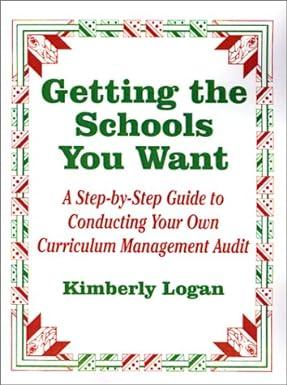Question
Backflush versus Traditional Costing: Variation 1 Potter Company has installed a JIT purchasing and manufacturing system and is using backflush accounting for its cost flows.
Backflush versus Traditional Costing: Variation 1
Potter Company has installed a JIT purchasing and manufacturing system and is using backflush accounting for its cost flows. It currently uses a two-trigger approach with the purchase of materials as the first trigger point and the completion of goods as the second trigger point. During the month of June, Potter had the following transactions:
| Raw materials purchased | $245,000 |
| Direct labor cost | 42,000 |
| Overhead cost | 210,750 |
| Conversion cost applied | 273,000* |
*$42,000 labor plus $231,000 overhead.
There were no beginning or ending inventories. All goods produced were sold with a 60 percent markup. Any variance is closed to Cost of Goods Sold. (Variances are recognized monthly.)
Required:
Question Content Area
1. Prepare the journal entries that would have been made using a traditional accounting approach for cost flows. Make your entries in the following order: (a) purchase of raw materials, (b) issuance of materials to production, (c) incurrence of direct labor cost, (d) incurrence of overhead cost, (e) application of overhead to production, (f) completion of goods, (g) cost of sales, (h) revenue from sales, and (i) recognition of the variance between applied and actual production costs.
| a. | Accounts ReceivableCashCost of Goods SoldFinished Goods InventoryMaterials Inventory | - Select - | |
| Accounts PayableAccounts ReceivableCost of Goods SoldFinished Goods InventoryMaterials Inventory | - Select - | ||
| b. | Materials InventoryOverhead ControlSales RevenueWages PayableWork-in-Process Inventory | - Select - | |
| Accounts PayableAccounts ReceivableCashCost of Goods SoldMaterials Inventory | - Select - | ||
| c. | Materials InventoryOverhead ControlSales RevenueWages PayableWork-in-Process Inventory | - Select - | |
| Materials InventoryOverhead ControlSales RevenueWages PayableWork-in-Process Inventory | - Select - | ||
| d. | Materials InventoryOverhead ControlSales RevenueWages PayableWork-in-Process Inventory | - Select - | |
| Accounts PayableAccounts ReceivableCost of Goods SoldFinished Goods InventoryMaterials Inventory | - Select - | ||
| e. | Materials InventoryOverhead ControlSales RevenueWages PayableWork-in-Process Inventory | - Select - | |
| Materials InventoryOverhead ControlSales RevenueWages PayableWork-in-Process Inventory | - Select - | ||
| f. | Finished Goods InventoryMaterials InventoryOverhead ControlSales RevenueWages Payable | - Select - | |
| Materials InventoryOverhead ControlSales RevenueWages PayableWork-in-Process Inventory | - Select - | ||
| g. | Accounts PayableCost of Goods SoldFinished Goods InventoryMaterials InventoryOverhead Control | - Select - | |
| Accounts PayableAccounts ReceivableCost of Goods SoldFinished Goods InventoryMaterials Inventory | - Select - | ||
| h. | Accounts PayableAccounts ReceivableFinished Goods InventoryMaterials InventoryOverhead Control | - Select - | |
| Accounts PayableAccounts ReceivableCashCost of Goods SoldSales Revenue | - Select - | ||
| i | Accounts PayableAccounts ReceivableCost of Goods SoldFinished Goods InventoryOverhead Control | - Select - | |
| Accounts PayableAccounts ReceivableCost of Goods SoldFinished Goods InventoryMaterials Inventory | - Select - |
Question Content Area
2. Prepare the journal entries for the month using backflush costing. For a compound transaction, if an amount box does not require an entry, leave it blank. Prepare your entries in the following order: (a) purchase of raw materials, (b) incurrence of direct labor and overhead costs, (c) completion of goods, (d) cost of sales, (e) sales revenue, and (f) recognition of the variance between applied and actual production costs.
| a. | Accounts PayableAccounts ReceivableConversion Cost ControlCost of Goods SoldRaw Materials and In Process Inventory | - Select - | |
| Accounts PayableAccounts ReceivableConversion Cost ControlCost of Goods SoldFinished Goods Inventory | - Select - | ||
| b. | Accounts PayableAccounts ReceivableConversion Cost ControlCost of Goods SoldFinished Goods Inventory | - Select - | - Select - |
| Accounts PayableAccounts ReceivableConversion Cost ControlCost of Goods SoldFinished Goods Inventory | - Select - | - Select - | |
| Accounts ReceivableConversion Cost ControlCost of Goods SoldFinished Goods InventoryWages Payable | - Select - | - Select - | |
| c. | Accounts PayableAccounts ReceivableConversion Cost ControlCost of Goods SoldFinished Goods Inventory | - Select - | - Select - |
| Accounts PayableCashConversion Cost ControlCost of Goods SoldFinished Goods Inventory | - Select - | - Select - | |
| Accounts PayableCashCost of Goods SoldFinished Goods InventoryRaw Materials and In Process Inventory | - Select - | - Select - | |
| d. | Accounts PayableConversion Cost ControlCost of Goods SoldFinished Goods InventoryRaw Materials and In Process Inventory | - Select - | |
| Accounts PayableAccounts ReceivableConversion Cost ControlCost of Goods SoldFinished Goods Inventory | - Select - | ||
| e. | Accounts PayableAccounts ReceivableConversion Cost ControlFinished Goods InventoryRaw Materials and In Process Inventory | - Select - | |
| Accounts PayableAccounts ReceivableConversion Cost ControlCost of Goods SoldSales Revenue | - Select - | ||
| f. | Accounts PayableAccounts ReceivableConversion Cost ControlCost of Goods SoldFinished Goods Inventory | - Select - | |
| Accounts PayableAccounts ReceivableConversion Cost ControlCost of Goods SoldFinished Goods Inventory | - Select - |
Step by Step Solution
There are 3 Steps involved in it
Step: 1

Get Instant Access to Expert-Tailored Solutions
See step-by-step solutions with expert insights and AI powered tools for academic success
Step: 2

Step: 3

Ace Your Homework with AI
Get the answers you need in no time with our AI-driven, step-by-step assistance
Get Started


